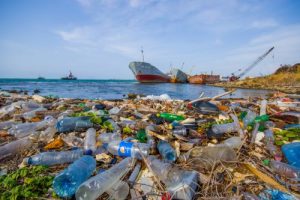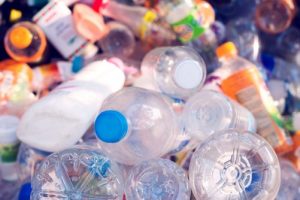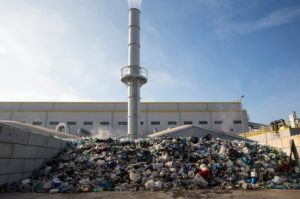By Carisse Hamlet, Thomas Matte and Sumi Mehta from the Vital Strategies Environmental Health Division.

The burning of garbage, especially plastics, is a major source of toxic air pollution
Earth Day, celebrated every April 22nd since 1970, is a worldwide moment that allows a global community to vocalize its support for environmental protection. In addition to shining a light on global environmental issues, Earth Day provides a unique opportunity to highlight the link between the well-being of the planet and human health. This year’s Earth Day theme — end plastic pollution — is particularly relevant to human health as The Lancet’s commission on pollution and health recently produced a report stating that pollution was the largest environmental cause of death and disease, responsible for over 9 million premature deaths around the globe in 2015. Air pollution is among the most pervasive environmental threats on human health, accounting for over two-thirds — more than 6 million — of the 9 million deaths linked to all environmental pollution. Plastic’s contribution to air pollution, especially in the world’s poorer countries, is an insidious but important way in which plastic pollution harms people today, not to mention the impact on future generations.
Since the initial wave in the 1940s, plastic production has grown rapidly with more than 330 million tons of plastic now being produced each year. One group of experts estimates that by 2015, humans had generated almost 7 billion tons of plastic trash, about 79% of which is building up in landfills and other places in the environment. Plastics are an especially challenging pollutant because the same durability qualities that have made it so popular are also responsible for its persistence in the environment. On average, plastic takes about 100 years to naturally decompose. This means that the plastic waste from humans continues to exist in forests, fields, beaches, and oceans long after they have been disposed of, causing significant harm to wildlife.

Plastic waste can take up to 100 years to naturally decompose
The impacts of plastic pollution on the environment and people are both highly visible — such as despoiled landscapes and beaches, and wildlife tangled in discarded plastic — and less obvious — such as microbeads from personal care products contaminating water and marine food chains. Another veiled consequence of plastic pollution exists in its contribution to toxic air pollution from the open burning of plastic-laden trash. Plastic remains a ubiquitous waste product everywhere in the world, and its slow rates of natural decomposition present an obstacle for the rapidly filling landfills in countries with formal solid waste management. In places without such facilities, solid waste is often disposed of inappropriately, including via open incineration — researchers estimate that over 40% of the world’s garbage is burned. In low and middle-income countries, where open waste burning is a widespread practice to dispose of garbage, combustion of plastics presents a major and potent pathway for human exposure to hazardous levels of outdoor air pollution.

Humans have generated more than 7 billion tons of plastic trash
In addition, plastics are abundant in electronic waste (e-waste), which is often incinerated in uncontrolled, unregulated e-waste recycling operations. Much of this informal e-waste recycling occurs in Asian and African countries — regions most impacted by the air pollution from multiple sources. Plastic in solid waste can also complicate separation of organic waste for composting, which is an important strategy for reducing landfill emissions of methane, an important climate pollutant and contributor to harmful ozone pollution.
Open burning of plastics also releases large amounts of toxic health and climate-damaging pollution including fine particles and black carbon, an important contributor to climate change. Polychlorinated biphenyls (PCBs), polycyclic aromatic hydrocarbons (PAHs), dioxins, and furans are among the most toxic chemicals commonly released into the air when burning plastic waste; chronic exposures cause cancer and interfere with hormone functions.
The World Health Organization (WHO), the United Nations Environment Program (UNEP), and the Climate and Clean Air Coalition (CCAC) a voluntary partnership of governments, the private sector, and civil society stakeholders committed to accelerating efforts to reduce short-lived climate pollutants (SLCPs), also recognize the strong links between pollution from solid waste burning, health and climate pollution. For example, WHO’s Urban Health Initiative has identified the improvement of municipal solid waste management in low- and middle-income cities as a major priority to improve both urban environmental conditions and health through replacing the common practice of open trash burning. The CCAC is supporting initiatives to provide technical assistance, training and knowledge sharing among governments, enabling the faster development of solid waste management plans that protect health and the environment.
The smarter solid waste management brought about through clean air policies will not only help reduce plastic’s contribution to air pollution, it will also reduce methane emissions from landfills as well as pollution from its production and carting. Additionally, the expanded use of modern waste-to-energy plants, already prevalent throughout Europe, can help eliminate waste while providing a means of power generation. For example, Koshe landfill, the largest rubbish dump site in Ethiopia, has been transformed into a waste-to-energy facility where state-of-the-art technology allows for highly efficient incineration of waste while operating below even the most stringent emission standards. Heat energy from the incineration process is used to generate enough electricity to fulfill the household energy needs of over 25% of the Ethiopian capital’s 3.4 million residents.

Waste-to-energy plants reduce landfill and replace fossil fuels in power generation
The public health community has a critical role to play in helping to end plastic pollution. In particular, quantifying the health burden and impact on health budgets and productivity can make the case for actions, including taxes on polluting products to discourage their use and investments in desperately needed pollution reduction measures, such as solid waste management programs and facilities. This Earth Day, shining a light on the ways plastics pollution directly impacts air quality and human health can be a powerful lever to improve the wellbeing of people and the planet.
CityHealth Perspective is a blog series that examines the importance of urban policies and environments on public health. Urban interventions are a strategic focus for our work and a core strength of our team. With the majority of the world’s population now urban and an additional 2.5 billion urban dwellers anticipated by 2050, we believe that public health must play a stronger role in shaping future cities that advance human and planetary health.